Making round lace eyelets into squares
Filet Lace Knitting aims to replicate beautiful even-count lace designs from other needlecrafts such as filet crochet and embroidery.
Dictionary definition
filet – A net or lace with a simple pattern of squares.
French, from Old French, diminutive of fil, thread, from Latin filum.
In this style of knitting lace, you will be following a charted pattern to work tiny blocks of “solid” and “open” squares. Even though we normally think of yarn overs as being “round”, I will show you an easy method to turn them into squares. (and no, I won’t be asking you to put a square peg in a round hole, lol)
The I Heart Filet Lace pattern we will be knitting for this month’s KAL is built line by line in 2-stitch, 2-row units that simulate the look of the chart. For chart-a-phobics, I have also included written instructions.
Note that we will be doing lace knitting (vs. knitted lace). Thus, there is the advantage of having plain “rest” rows of knitting that alternate with the patterned yarn over rows.
A Bit of History
Perhaps you are already familiar with filet crochet? If so, then you can think of Filet Lace Knitting as more or less equivalent to filet crochet.
Filet crochet is itself an adaptation of earlier even-count needle lace embroideries such as withdrawn thread and antique darned netting. Net darning, also called filet lace, is a 19th-century technique using stitching on a mesh foundation fabric to imitate lace.
In even-count lace, the basis of the pattern designs is a simple square. The squares become a pattern by the way solid and open squares are arranged in rows and columns.
Examples of withdrawn thread and pulled thread embroidery laces
Filet lace designs can range from simple to elaborate. There are many beautiful graphs for filet crochet and even-count embroideries. However, seldom do we see this style of lace adapted to knitting. The challenge, of course, is that the typical knitted stitch itself is rectangular (width is greater than height), so whatever method(s) are used would need to coerce the stitches into a square where width equals height.
Replicating Net Darning
Our goal in Filet Lace Knitting is to produce a square mesh as in netting, with a planned design of filled squares to suggest the pattern as though the netting were darned upon a foundation of the mesh.
In surveying the documented knitting methods to reproduce filet, all have pluses and minuses of how well they replicate the net darning family of needle lace embroidery techniques. The factors I considered when doing my research and experiments with different methods were:
- Ease of converting from a graphed even-count chart
- Tediousness in working
- Degree of over-all look in replicating darned filet
- Relative thickness of horizontals and verticals
- Tendency to distort in solid areas vs open spaces
- Tendency to bias
For example, the Mary Thomas is documented in the Mary Thomas’ Book of Knitting Patterns, starting on page 263. Each unit is 3 stitches by 4 rows of garter stitch-based lace. It is easy to translate the method directly from an even-count chart, but otherwise fails on most other factors. It is quite fiddly to work. Also, the “open space” has an extra horizontal bar across the middle, making the space not totally open and thus being an irritating design distraction.
The Burda method is another interesting approach to knitting filet lace. Each unit is 2 stitches by 4 rows of stockinette stitch-based lace. Again, it is easy to translate the method directly from an even-count chart, and at least is not quite as fiddly imho to work. Plus has the advantage of actually having open spaces. Unfortunately the spaces are rounded rather than squared. Plus the verticals are quite thick. If not attempting to mimic the squares of filet lace, this would probably be a satisfactory method to work an even-count design.
I won’t bore you with all the other simpler and more complex methods I found and experimented with, but that gives you an idea of my thought process.
Not really being satisfied with any methods I found already documented, I proceeded to devise my own. After many failed and not-quite-satisfactory experiments, I finally came up with a method that I feel gets good marks on all except the last factor. And for that I will give you tips to remedy the bias with proper choice of yarn and by doing a good blocking.
Pattern Units
Filet lace knitting is composed of Blocks (solid, filled squares) and Spaces (open, unfilled squares). The background is open and the design is solid (positive vs. negative space)
Filet Lace Knitting the “Jackie E-S Way” relies on 2 stitch sequences that might be new to you:
- To make open squares, you will use the ktd (knit through decrease).
- To make solid squares, you will use the yokp (yarn over, k1, pass yo over).
I will cover these special stitch sequences in other articles coming up soon.
Next up: Tips for Selecting Materials and Supplies to Knit Filet Lace

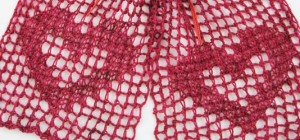
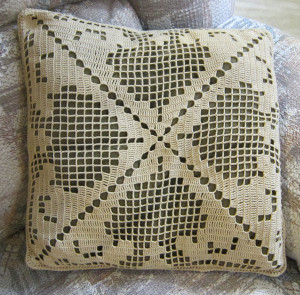
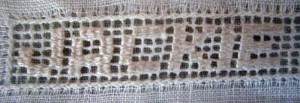
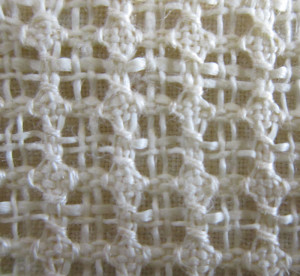
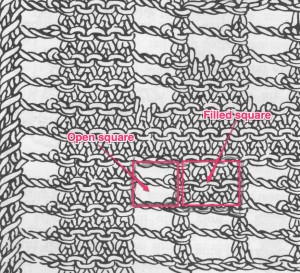
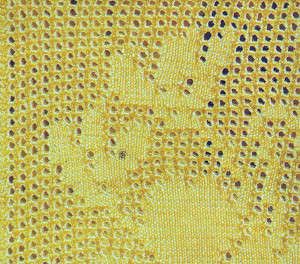
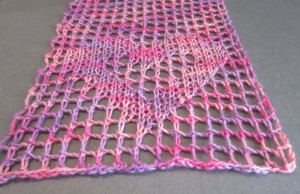

 HeartStrings FiberArts
HeartStrings FiberArts Knitting Bits of Lace on Facebook
Knitting Bits of Lace on Facebook Ravelry Store
Ravelry Store
Pingback: Free stitch pattern: Knit Net | String Geekery